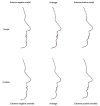Incisor Occlusion Affects Profile Shape Variation in Middle-Aged Adults
- PMID: 33671163
- PMCID: PMC7923002
- DOI: 10.3390/jcm10040800
Incisor Occlusion Affects Profile Shape Variation in Middle-Aged Adults
Abstract
Background: The aim of this study was to assess the effect of overjet and overbite on profile shape in middle-aged individuals.
Methods: The study population comprised 1754 46-year-old individuals, members of the 1966 Northern Finland Birth Cohort. Their profile images were digitized using 48 landmarks and semi-landmarks. The subsequent landmark coordinates were then transformed to shape coordinates through Procrustes Superimposition, and final data were reduced into Principal Components (PCs) of shape. Overjet and overbite values were measured manually, during a clinical examination. A multivariate regression model was developed to evaluate the effect of overjet and overbite on profile shape.
Results: The first nine PCs described more than 90% of profile shape variation in the sample and were used as the shape variables in all subsequent analyses. Overjet predicted 21.3% of profile shape in the entire sample (η2overjet = 0.213; p < 0.001), while the effect of overbite was weaker (η2overbite = 0.138; p < 0.001). In males, the equivalent effects were 22.6% for overjet and 14% for overbite, and in females, 25.5% and 13.5%, respectively.
Conclusion: Incisor occlusion has a noteworthy effect on profile shape in middle-aged adults. Its impact becomes more significant taking into consideration the large variety of genetic and environmental factors affecting soft tissue profile.
Keywords: adults; morphometrics; occlusion; overbite; overjet; profile shape.
Conflict of interest statement
Demetrios Halazonetis owns stock in dHAL Software, the company that markets Viewbox 4. The other authors declare no conflict of interest.
Figures



Similar articles
-
Influence of overjet and overbite on soft tissue profile in mature adults: A cross-sectional population study.Am J Orthod Dentofacial Orthop. 2019 Jan;155(1):57-63.e3. doi: 10.1016/j.ajodo.2018.02.015. Am J Orthod Dentofacial Orthop. 2019. PMID: 30591167
-
Changes in incisor relationship over the life course - Findings from a cohort study.J Dent. 2022 Feb;117:103919. doi: 10.1016/j.jdent.2021.103919. Epub 2021 Dec 10. J Dent. 2022. PMID: 34896441
-
Profile shape variation and sexual dimorphism amongst middle-aged Northern Europeans.Eur J Orthod. 2022 Jan 25;44(1):30-36. doi: 10.1093/ejo/cjab004. Eur J Orthod. 2022. PMID: 33822026
-
[Principles and methods of geometric morphometrics].Zh Obshch Biol. 2002 Nov-Dec;63(6):473-93. Zh Obshch Biol. 2002. PMID: 12510587 Review. Russian.
-
One phase or two phase orthodontic treatment for Class II division 1 malocclusion ?Evid Based Dent. 2019 Sep;20(3):72-73. doi: 10.1038/s41432-019-0049-y. Evid Based Dent. 2019. PMID: 31562403 Review.
Cited by
-
The effect of orthodontic treatment on smile attractiveness: a systematic review.Prog Orthod. 2023 Feb 6;24(1):4. doi: 10.1186/s40510-023-00456-5. Prog Orthod. 2023. PMID: 36740663 Free PMC article.
-
New Approaches and Technologies in Orthodontics.J Clin Med. 2024 Apr 24;13(9):2470. doi: 10.3390/jcm13092470. J Clin Med. 2024. PMID: 38730999 Free PMC article.
-
Number of Teeth Is Related to Craniofacial Morphology in Humans.Biology (Basel). 2022 Apr 1;11(4):544. doi: 10.3390/biology11040544. Biology (Basel). 2022. PMID: 35453743 Free PMC article.
References
-
- Gangestad S.W., Scheyd G.J., Scheyd G.J. The Evolution of Human Physical Attractiveness. Annu. Rev. Anthropol. 2005;34:523–548. doi: 10.1146/annurev.anthro.33.070203.143733. - DOI
Grants and funding
LinkOut - more resources
Full Text Sources
Other Literature Sources

